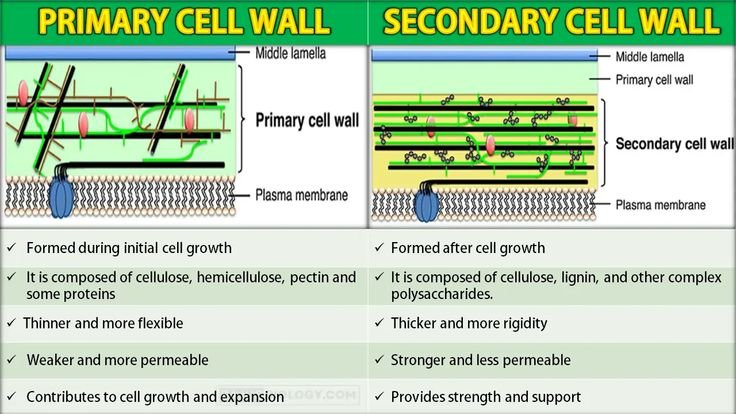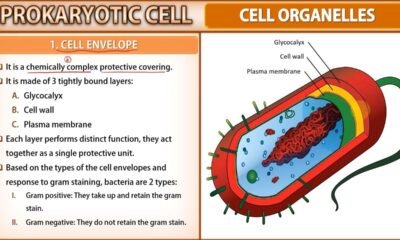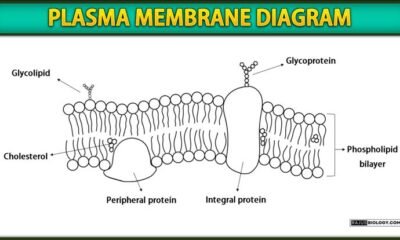Blog
Difference Between Primary and Secondary Cell Wall

In this article we will discuss about difference between primary and secondary cell wall
Difference between primary and secondary cell wall
1. Formation: Primary cell wall is formed during initial stages of cell growth and is deposited between the plasma membrane and the expanding cell. The secondary cell wall is formed after cell growth is complete and is deposited inside the primary cell wall.
2 Composition: The primary cell wall is composed of cellulose, hemicellulose, pectin and some structural proteins. The secondary cell wall is mainly composed of cellulose, lignin and other complex polysaccharides.
3. Thickness: The primary cell wall is thin and flexible, allowing for cell enlarge and growth. The secondary cell wall is thicker and provides rigidity and support to the cell.
4. Strength: The primary cell wall provides initial strength and protection to the cell, but it is weak compared to the secondary cell wall. The secondary cell wall provides strength and ability to withstand mechanical stress.
5. Permeability: The primary cell wall is more permeable. This allows for exchange of nutrients, water and gases between cell and its environment. The secondary cell wall is less permeable and acts as a barrier, limiting the passage of molecules.
6. Flexibility: The primary cell wall is more flexible and elastic. The secondary cell wall is rigid and provides structural support, making the cell more stable.
7. Growth: The primary cell wall undergoes expansion and growth along with the cell during its development. The secondary cell wall is deposited after cell expansion is complete and does not contribute to cell growth.
8. Lignification: Lignin, a complex polymer, is present in the secondary cell wall but absent or present in small amounts in the primary cell wall. The Lignin provides rigidity and hydrophobicity to the secondary cell wall, making it resistant to pathogen attack and water absorption.
9. Cell Function: The primary cell wall is involved in various cellular processes such as cell elongation, cell differentiation, and cell-cell communication. The secondary cell wall primarily serves as a protective layer, providing mechanical strength.
10. Regeneration: The primary cell wall can be regenerated after cell division, allowing for cell growth and expansion. The secondary cell wall is not regenerated and remains relatively stable once formed.
Summary: Difference between primary and secondary cell wall
- Primary cell wall is formed during initial cell growth, while secondary cell wall is formed after cell expansion.
- Primary cell wall is composed of cellulose, hemicellulose, and pectin, while secondary cell wall is composed of cellulose, lignin, and other complex polysaccharides.
- Primary cell wall is thinner and more flexible, while secondary cell wall is thicker and provides rigidity.
- Primary cell wall is relatively weaker and more permeable, while secondary cell wall is stronger and less permeable.
- Primary cell wall contributes to cell growth and expansion, while secondary cell wall provides strength and support.
- Primary cell wall is more elastic, while secondary cell wall is rigid.
- Primary cell wall is involved in various cellular functions, while secondary cell wall primarily serves as a protective layer.
- Lignin is present in the secondary cell wall but absent or in small amounts in the primary cell wall.
- Primary cell wall can be regenerated, while secondary cell wall remains stable.

 Blog7 months ago
Blog7 months ago[PPT] Human Reproduction Class 12 Notes
- Blog7 months ago
Contribution of Indian Phycologists (4 Famous Algologist)
- Blog7 months ago
PG TRB Botany Study Material PDF Free Download

 Blog7 months ago
Blog7 months agoCell The Unit of Life Complete Notes | Class 11 & NEET Free Notes

 Blog7 months ago
Blog7 months ago[PPT] The living world Class 11 Notes

 Blog7 months ago
Blog7 months agoClassification of Algae By Fritsch (11 Classes of Algae)

 Blog7 months ago
Blog7 months agoJulus General Characteristics | Free Biology Notes

 Blog7 months ago
Blog7 months agoPlasma Membrane Structure and Functions | Free Biology Notes














